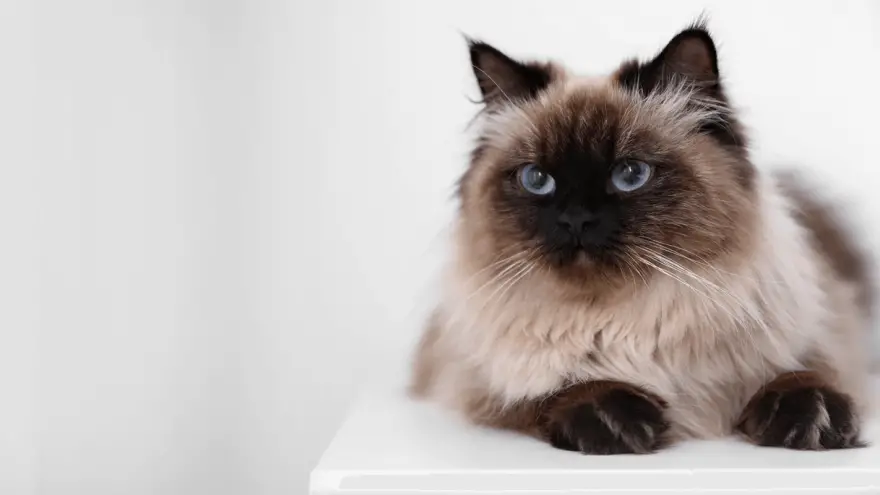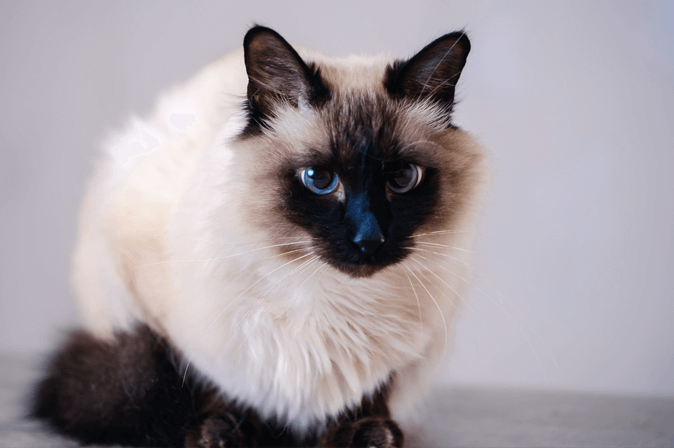
Balinese
The Balinese and the Siamese are practically the same breeds. There are tiny differences in their DNA, resulting in different coats. The handsome Balinese is incredibly soft and fluffy, which is exactly what cat owners seem to want. These cats will follow their people around the home, so it might not be the best choice for those that need walking assistance. Nevertheless, the Balinese makes a wonderful family pet. Here’s what all cat fanciers have to know about this cat breed.

Length:
12–18 in

Weight:
5-10 lb

Origin:
Thailand

Life Expectancy:
9-15 years
Breed History
As you can imagine, the history of the Balinese cannot be discussed without discussing the Siamese history. The main difference is a naturally occurring mutation that caused the Siamese, a naturally shorthaired breed, to grow a longer coat. That means their history is one and the same until the 1940s and 1950s. Cat breeders noticed how attractive a longhaired Siamese is, so they decided to develop the breed as an independent one. The Balinese received international recognition in 1961 and was named after the beautiful dancers from the Island of Bali.
Cat Breed Characteristics
There are apparent differences between the Balinese and the Siamese - their coats. However, the rest of their characteristics, like head shape, eye color, and size, are exactly the same. If you stip these two breeds to their skin, the two cats would be indistinguishable. Here are the main characteristics of the Balinese.
Coat
The first thing we will focus on is the Balinese’s coat. This is the first thing most of us will notice about them. Unlike most longhaired cat breeds, the Balinese doesn’t have a fluffy, insulating undercoat. Their coat should be medium-long, although individual cats can grow long coats. The coat is very fluffy and soft.

Coat color
All cat breeds have a clearly defined set of colors they can come in. The Balinese can come in chocolate, lilac, seal, blue, red, and cream point. All of these colors should be accompanied by tortoiseshell or lynx points.
Size
One of the most important things all future Balinese owners need to know is their future cat’s size. You don’t want to end up with a huge cat, like the Maine Coon, if you’re looking for a small apartment pet. The Balinese is considered medium-sized, and the adults usually weigh 5 - 10 pounds.
Temperament
The physical appearance of a cat is important. However, its temperament is something future owners should really focus on. The good news is that the Balinese is a fantastic pet. These cats love following their owners around their home, and as soon as you sit down, this cat will most likely jump into your lap. They love sleeping next to their humans. This breed is considered agile, intelligent, and very playful. Don’t be surprised if your Balinese responds well and fast to positive training methods.
Health
Like the Siamese, the Balinese are prone to breed-specific health issues. Since their DNA is practically the same, the health issues that can be problematic for the Siamese are the same things that worry the Balinese owners. That doesn’t mean the cat will develop these issues; it just means you and your vet should keep an eye on your cat. The potential health issues are;
- Congenital heart defects - Different heart issues can develop, so it is best to check your cat regularly.
- Crossed eyes - This is a common issue for the Siamese, but it is only esthetic. It shouldn’t affect the cat’s overall health.
- Amyloidosis - This disease causes the amyloid protein to deposit in the cat’s organs, mainly in the kidneys and liver.
- Respiratory issues - Diseases like asthma and other bronchial diseases are somewhat common.
- Hyperesthesia syndrome - This issue will cause the cat to “overgroom” itself and cause hair loss. The cat will also “freak out” when someone pets it.
- Lymphoma - A type of cancer.
- Nystagmus - A neurological disorder that will cause the cat’s eyes to move rapidly from side to side.
World Cat Finder Team

Updated at21.12.2021.

Share